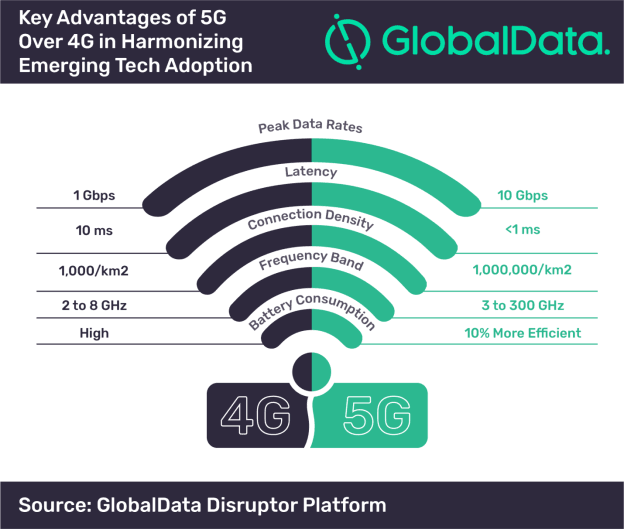The intrinsic capacity of the fifth-generation cellular technology (5G) to connect the Internet’s end systems with enhanced data flows and faster response times will unlock the full potential of emerging technologies, according to GlobalData, a leading data and analytics company. Archi Dasgupta, Director of Disruptive Tech at GlobalData, comments:
“In addition to the striking speed, which enables data transmission between two end systems almost instantly, 5G’s ability to connect thousands of such devices at once with lower latency, higher reliability and lesser battery consumption lays a strong foundation for the effective adoption of emerging technologies.”
An analysis of GlobalData’s Disruptor Tech Database reveals how 5G can influence the deployment of emerging technologies, notably Internet of Things (IoT), autonomous vehicles, robotics & drones and virtual reality (VR).

Key advantages of 5G over 4G in harmonizing emerging tech adoption. Source: GlobalData
IoT
5G can find its major use case in helping IoT applications to overcome the limitations of 4G in industries such as mining, where lower latency and reliability are critical for daily operations and safety. Swedish miner Boliden collaborated with Ericsson to deploy 5G at its Aitik mine fitted with hundreds of sensors for industrial automation. Boliden expects to uncover a potential business value of over €2.5m (US$2.7m) in net savings annually with the use of 5G networks.
Autonomous vehicles
The cellular vehicle-to-everything (C-V2X) communication project by 5G Automotive Association (5GAA) consortium, which has Audi and BMW as members, is looking up to 5G to extend communication range and enable faster data transmission between numerous sensors in the driving environment and centralized servers to coordinate autonomous driving safely and efficiently.
Robotics & drones
5G can fill the gaps in 4G with virtually instantaneous response times essential for robots to process more data in real-time, absorb new things and better communicate with the real world. While a 5G robot by KT Corp is already active in South Korea for coffee making, the technology is expected to be the key enabler of next-generation robotic applications such as telesurgery. 5G’s elevated bandwidth will enable drones to shoot live 4K or 360-degree videos through their cameras and revolutionize the way people watch videos.
VR
The widespread adoption of VR depends on reliable 5G networks as the immersive technology consumes huge data. The VR head-mounted displays currently require a powerful PC to run and store, which means the experiences are confined to a location and requires high power. The edge cloud capabilities of 5G look to have a solution for all these problems. Dasgupta concludes:
“While the commercial adoption of 5G for broader industrial applications is expected to take off in the early 2020s, its mainstream adoption could take longer due to several hurdles–the most crucial being cost. As the technology uses a totally different wavelength and needs much higher bandwidth compared to 4G and 3G, it requires network operators to replace the entire existing infrastructure. However, 5G adoptions will increase gradually and complement the effective implementation of emerging technologies.”